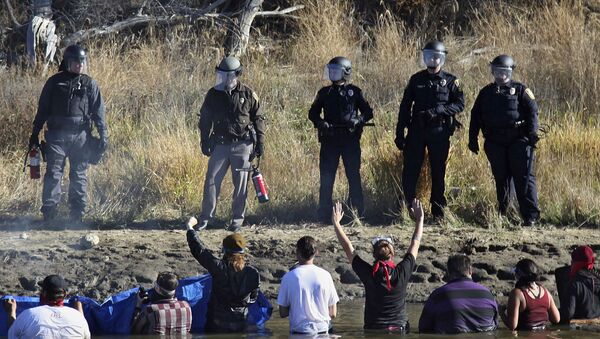WASHINGTON (Sputnik) – “It’s been stated by a number of native leaders…that the [camp] territory is 1851 Treaty of Fort Laramie territory that was taken illegally,” said Michael Knudsen, logistics coordinator with the tribe’s Medic and Healer Council. “So [protesters] are not inclined to move regardless of the statements of the US Army Corps of Engineers or Governor [Jack] Dalrymple.”
In the 165-year-old treaty, the US government recognized all land cited in the agreement as native, or American Indian, territory and asserted no claim to any of it. However, Knudsen said, Washington has repeatedly violated the treaty, prompting protesters – some of whom are descendants of treaty signatories – have reoccupied the land.
On Saturday, the Army Corps notified Standing Rock Sioux leaders that as of December 5 areas of Corps-managed land north of the Cannonball River, including the protesters’ Oceti Sakowin camp, would be closed to the public. However, the agency stressed that it doesn’t intend to forcibly remove people from federal land.
“Those who choose to stay do so at their own risk as emergency, fire, medical, and law enforcement response cannot be adequately provided in these areas,” the Army Corps stated in a news release Sunday. “Those who remain will be considered unauthorized and may be subject to citation under federal, state, or local laws.”
However, the governor’s order drew a rebuke from Standing Rock Sioux chairman Dave Archambault, who called it a precursor to further human-rights violations of the protesters, who have been attacked by police dogs and blasted with water cannons during frigid weather.
“This state executive order is a menacing action meant to cause fear, and is a blatant attempt by the state and local officials to usurp and circumvent federal authority,” Archambault said in a statement late Monday.
The tribal leader said that if Dalrymple is concerned about public safety, he should remove barriers meant to contain protesters and demand that the Morton County sheriff’s department stop using water cannons and other crowd-control tactics such as flash grenades and dog kennels to detain protesters.
The Army Corps, which reviews pipeline-construction permits for the US Department of Interior, has said it’s seeking additional information from the Standing Rock Sioux, who object to the pipeline because it threatens sacred tribal lands and would pollute water from the Missouri River’s Lake Oahe reservoir as part of the project’s four-state, nearly 1,200-mile route.
“At this point, because of the Army Corps’ lack of a response, sacred sites have been destroyed and have been disturbed by Dakota Access,” Knudsen told Sputnik. “It’s not a matter of those sacred sites being potentially threatened by the construction of the pipeline. … Now it’s a last stand to try to prevent that pipeline operation, and the inevitable eventuality, of it leaking at some point and trying to protect the Missouri River.”
The Army Corps is awaiting approval of a legal easement, or land-crossing right, that the Interior Department is considering for final-stage construction of the pipeline. If granted, the easement would allow the companies investing in the pipeline to build a tunnel to carry natural gas under Lake Oahe.
The $3.7 billion Dakota Access Pipeline is intended to transport domestically produced light crude oil from North Dakota through the states of South Dakota and Iowa into Illinois.



